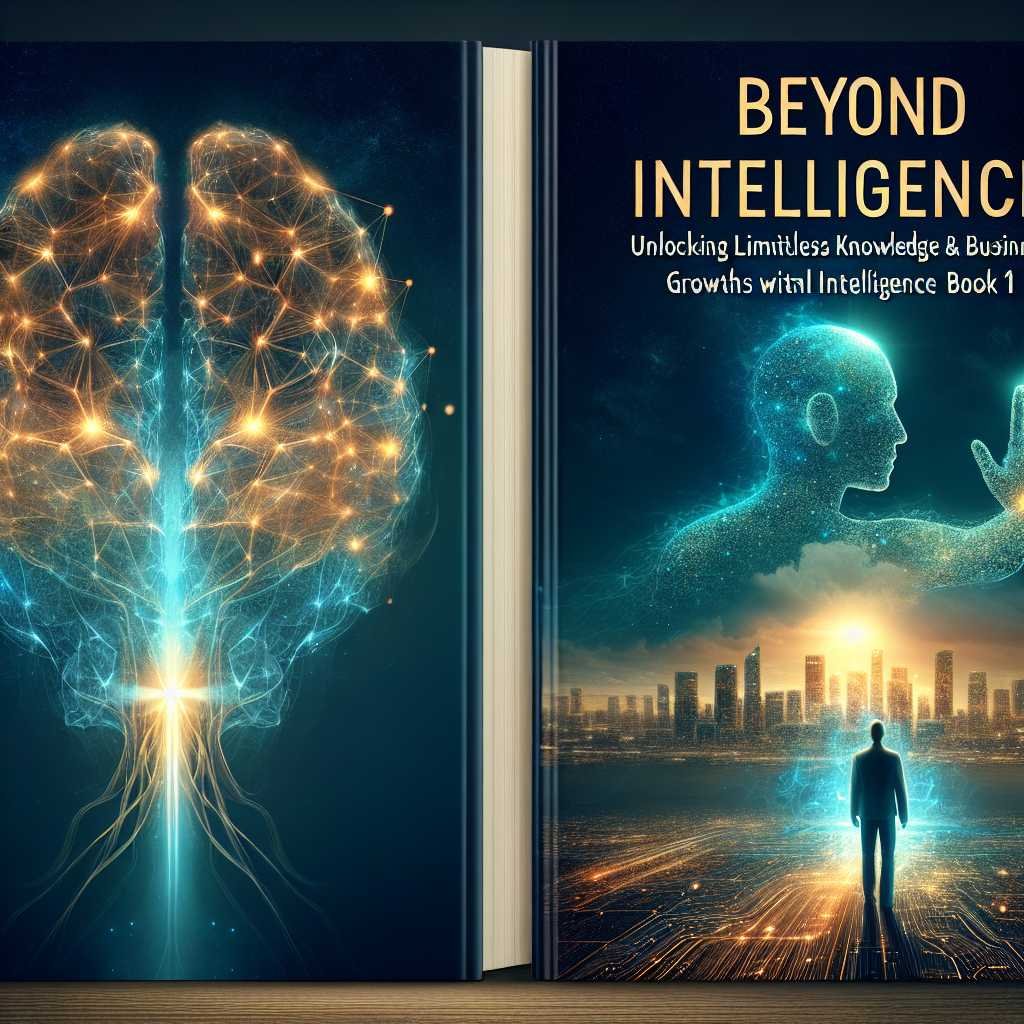Beyond Intelligence: How ChatGPT Unlocks Limitless Knowledge and Business Growth (Mastering Artificial Intelligence Book 1)
You’ve probably felt it: the nagging gap between what you want to accomplish and how fast you can learn, decide, and ship. We’ve all been there—tabs overflowing, tutorials queued, ideas half-baked because the ramp-up is too steep or time is too tight. The old way of learning relied on gatekeepers, slow feedback loops, and sheer endurance. It rewarded the patient and the privileged. But today, the ground has shifted.
Enter ChatGPT. Not as a gadget, not as a fad—but as a force multiplier for your brain and your business. This post explores why intelligence alone was never the full story, how AI breaks decades-old barriers to knowledge and productivity, and what the book Beyond Intelligence: Unlocking Limitless Knowledge & Business Growth with ChatGPT (Mastering Artificial Intelligence Book 1) will teach you about wielding this superpower with confidence and real-world impact.
The old barriers of knowledge—and why we struggled
For most of modern history, knowledge moved slowly. If you wanted to master a topic, you had to:
- Find the right expert or textbook.
- Spend weeks decoding jargon and context.
- Practice alone, with little feedback.
- Repeat until proficiency showed up—if it ever did.
Even in the internet era, we hit new ceilings:
- Information overload: There’s too much content and not enough clarity.
- Gatekeeping by complexity: Technical knowledge is locked behind dense papers, paywalled journals, or corporate silos.
- Time poverty: You may have one hour between meetings to research, summarize, and decide—and that’s not enough.
Worse, our brains have limits. Cognitive load is real; we can’t juggle infinite context or endless options without guidance. That’s why skill-building can feel like climbing a hill in sand—every step slides back just a little. It’s not that you’re not smart. It’s that the system was never designed for speed.
Why “intelligence” alone wasn’t enough—the missing link
Being smart helps, but it doesn’t guarantee impact. What separates high-output operators from everyone else isn’t raw IQ—it’s leverage. Leverage looks like:
- On-demand research that matches your context.
- Clear summaries that cut through noise.
- Iterative feedback that teaches as you go.
- The ability to simulate expertise across domains (marketing, legal, analytics) without 10 years in each field.
Think of intelligence as horsepower and leverage as the transmission. Without the right gears, the engine can’t transfer power to the road. Research backs this up: when people get the right AI assistance, their productivity and quality both rise—especially on knowledge-heavy tasks. A rigorous study from the National Bureau of Economic Research found that generative AI boosted task performance for knowledge workers by 14% on average, with the largest gains for less experienced users who got “lifted” by AI guidance (NBER). In other words, AI narrows the gap between intention and execution.
How ChatGPT tears down barriers to knowledge and productivity
ChatGPT converts static knowledge into a dynamic, two-way learning loop. It:
- Summarizes complex sources in your voice and for your audience.
- Translates jargon into plain language and plain language into polished deliverables.
- Brainstorms alternatives you hadn’t considered and applies constraints (budget, deadlines, tone).
- Creates first drafts of emails, memos, sales pages, or code you can refine fast.
- Turns scattered notes into structured frameworks, SOPs, and project plans.
Crucially, it learns your context in-session. You can paste policies, customer profiles, brand guidelines, or product specs and ask the model to think within those boundaries. When used well—through clear prompting, iteration, and verification—ChatGPT becomes an always-on strategist, editor, and analyst. That’s not hyperbole; it’s leverage.
Curious to apply these techniques step-by-step—Check it on Amazon.
If you want to dive deeper into how to prompt effectively, start with the official guidance on structuring instructions, breaking tasks into steps, and providing examples (OpenAI prompt engineering guide).
The AI revolution isn’t just tech—it’s a new superpower for business and life
This isn’t just another app; it’s a new way of working. Here’s what that looks like in practice across roles.
For founders and solopreneurs
- Validate ideas fast with simulated customer interviews.
- Generate and A/B test landing page copy in hours, not weeks.
- Turn feature brainstorms into prioritized roadmaps with effort/impact scoring.
- Draft investor updates that are clear, data-driven, and human.
For growth and marketing teams
- Create content calendars tuned to search intent and buyer stages.
- Summarize customer reviews to surface pain points and messaging hooks.
- Spin up SEO outlines and source credible references fast.
- Repurpose long-form content into email sequences, short videos, and social posts.
For operations and enablement
- Convert messy process notes into polished SOPs and checklists.
- Create training modules from tribal knowledge.
- Draft knowledge base articles while capturing edge cases.
- Standardize handoffs between teams to reduce friction.
For analysts and product managers
- Summarize datasets and propose hypotheses to test.
- Write structured product specs, acceptance criteria, and user stories.
- Draft PRDs and align them to company goals with measurable outcomes.
For creators, students, and educators
- Transform rough outlines into cohesive essays or scripts.
- Generate quiz questions, rubrics, and study plans.
- Summarize research papers and explain concepts at different reading levels.
The macro picture is clear, too. McKinsey estimates generative AI could add trillions of dollars in annual value by accelerating tasks across marketing, sales, software engineering, and customer operations (McKinsey). The Stanford AI Index tracks rapid gains in capability and accessibility year over year, with clear implications for knowledge work (Stanford HAI AI Index).
Want a ready-made playbook with prompts and case studies—See price on Amazon.
What this book will do: teach you to wield that superpower
Beyond Intelligence: Unlocking Limitless Knowledge & Business Growth with ChatGPT is designed as a hands-on manual, not a lecture. Here’s how it helps you level up:
- It demystifies ChatGPT by showing how to turn questions into outcomes.
- It gives you reusable prompt frameworks for research, writing, analysis, ideation, and automation.
- It shows real business workflows—marketing funnels, sales enablement, product planning—and where AI fits.
- It teaches you how to think with AI: how to decompose problems, check assumptions, and iterate.
- It covers pitfalls like hallucinations, bias, and overreliance—plus practical safeguards.
You’ll learn to create an “AI layer” across your work: reusable templates, custom instructions, team playbooks, and metrics for measuring impact. Think of it as equipping your organization with an operating system for fast learning and consistent output.
Ready to turn ChatGPT into a daily growth engine—Buy on Amazon.
The practical playbook: frameworks you’ll use every day
Here are a few field-tested frameworks you can apply right away.
- AIR Loop (Ask, Iterate, Refine):
- Ask: State the goal, constraints, audience, and format.
- Iterate: Request variations, edge cases, and counterarguments.
- Refine: Provide feedback and source material; push for clarity and actionability.
- SCQA Prompting (Situation, Complication, Question, Answer):
- Provide context so the model sets the stage correctly.
- Define the problem blocking progress.
- Ask a precise question.
- Request an answer in a specific structure (e.g., “3 options with pros/cons and a recommendation”).
- Laddering Detail:
- Start with the big picture; ask for a one-paragraph answer.
- Drill down: “Explain like I’m 12,” then “Explain like I’m a CFO,” then “Give me the SQL.”
- This lets you control depth and check understanding at each step.
- Guardrail Prompts:
- “If you don’t know, say so and suggest how we could find out.”
- “Cite sources and flag any low-confidence claims.”
- “Summarize any assumptions you made.”
These approaches reduce errors, increase clarity, and keep the model aligned to your goals. For more examples, review industry best practices and testing methods described by organizations like NIST’s AI Risk Management Framework.
Choosing your AI toolkit and the right edition (buying tips)
To get the most out of this book—and ChatGPT—you’ll want a simple, reliable setup.
- Which ChatGPT version?
- If you rely on advanced reasoning and larger context windows, a premium model often pays for itself in time saved. Check what’s available and suited to your use case via the OpenAI model overview.
- For teams, consider enterprise or business plans for better data controls and admin features.
- Privacy and data sensitivity
- Never paste confidential data without safeguards.
- Use organization-level controls and clear policies; reference frameworks like NIST’s AI RMF for governance.
- Tools to pair with ChatGPT
- Note-taking: capture prompts and outputs in a knowledge system (e.g., Notion, Obsidian).
- Automation: connect ChatGPT to apps via APIs or workflow tools for repetitive tasks.
- Analytics: track content performance, user behavior, or sales impact to quantify ROI.
- Format and reading experience
- Kindle is great for search, highlights, and copying prompts to your workspace.
- Paperback works well for note-taking and team workshops.
- Audiobook helps you absorb strategy on the go; follow up by copying prompts for hands-on practice.
Comparing formats or gifting it to a teammate—Shop on Amazon.
7 quick wins you can implement today
Steal these starter prompts and adapt them to your goals.
1) Create a customer persona from real feedback
“Here are 20 customer reviews; summarize the top 5 problems, desired outcomes, and exact phrases they use. Then produce a persona with goals, anxieties, and buying triggers.”
2) Turn research into a decision memo
“Summarize the attached sources into a 1-page memo with a recommendation, 3 alternatives, risks, mitigations, and next steps.”
3) Draft an SEO outline
“Using these keywords and audience, create an outline with H2/H3s, search intent, FAQs, and internal link ideas.”
4) Build a sales email sequence
“Write a 4-email sequence for [ICP], each 120–150 words, objection-first, with one clear CTA per email.”
5) Convert a meeting transcript into action
“From this transcript, pull decisions, owners, deadlines, and open questions. Format as a checklist and a Slack-ready summary.”
6) Design an onboarding playbook
“Create a 2-week onboarding plan for a junior marketer, with daily tasks, learning goals, and deliverables.”
7) Spot errors and missing context
“Act as a skeptical reviewer; list assumptions, missing data, and the top 5 questions I must answer before launch.”
For broader strategy, Harvard Business Review’s guidance on using generative AI to deliver business value is a useful complement to hands-on practice (HBR).
Common pitfalls—and how to avoid them
- Treating first drafts as final
- AI is a collaborator, not a finish line. Always review for accuracy, tone, and policy compliance.
- Hallucinations and false certainty
- Ask the model to cite sources and flag low confidence. Verify facts and numbers before shipping. See the official advice on constraints and verification in the OpenAI prompt engineering guide.
- Over-automation without oversight
- Start with human-in-the-loop workflows. Automate stable, low-risk tasks first.
- Poor context and vague instructions
- Provide audience, format, constraints, and examples. It’s the difference between “meh” and “nailed it.”
- No success metrics
- Define what “good” looks like: saved hours, increased conversion, faster cycle time, fewer support tickets.
- Data hygiene issues
- Create standard operating procedures for what can and cannot be shared with AI systems. Align with governance frameworks like NIST’s AI RMF.
Where to go next
If you’ve read this far, you’re serious about using AI as leverage. The next step is to pick one workflow—content, research, sales, or ops—and build an AI-assisted process you can run weekly, measure, and improve. Apply the frameworks above, then expand to the rest of your stack.
Prefer to skim reviews before diving in—View on Amazon.
Conclusion: The clear takeaway
Intelligence was never the bottleneck—access, context, and iteration were. ChatGPT collapses those barriers so you can learn faster, decide smarter, and build momentum. The moment you treat AI as a partner instead of a novelty, your output compounds. If this resonated, subscribe for more practical playbooks—or pick one workflow today and ship something you’ve been putting off.
FAQ
Q: Is ChatGPT enough to run a business, or is it just for content?
A: It’s a general-purpose reasoning and language engine. It can support research, planning, customer support drafts, sales enablement, basic analytics, and documentation. You still need strategy, data, and human judgment. Use AI to accelerate, not to abdicate.
Q: How do I avoid hallucinations and mistakes?
A: Provide context, cite sources, ask for uncertainty flags, and verify claims. Use guardrail prompts (“If unsure, say so”) and keep a human in the loop for high-stakes output.
Q: Do I need coding skills to benefit?
A: No. Clear instructions and iteration matter most. Coding helps if you want to automate workflows or connect APIs, but it’s optional for everyday productivity.
Q: Which ChatGPT version should I choose?
A: If you’re doing complex reasoning or large-context tasks, choose a stronger model when available; check the latest options in the OpenAI model overview. For teams, consider business/enterprise tiers for governance and admin features.
Q: Is my data safe with AI tools?
A: It depends on your plan and settings. Avoid sharing confidential information unless you have enterprise controls and policies in place. Follow your organization’s security standards and align with frameworks like NIST’s AI Risk Management Framework.
Q: What ROI should I expect?
A: Look for measurable improvements in cycle time (hours saved), output quality (engagement, conversions), and throughput (more campaigns or specs shipped). Studies suggest double-digit productivity gains when AI is used systematically—start small, measure, and scale (NBER; McKinsey).
Discover more at InnoVirtuoso.com
I would love some feedback on my writing so if you have any, please don’t hesitate to leave a comment around here or in any platforms that is convenient for you.
For more on tech and other topics, explore InnoVirtuoso.com anytime. Subscribe to my newsletter and join our growing community—we’ll create something magical together. I promise, it’ll never be boring!
Stay updated with the latest news—subscribe to our newsletter today!
Thank you all—wishing you an amazing day ahead!
Read more related Articles at InnoVirtuoso
- How to Completely Turn Off Google AI on Your Android Phone
- The Best AI Jokes of the Month: February Edition
- Introducing SpoofDPI: Bypassing Deep Packet Inspection
- Getting Started with shadps4: Your Guide to the PlayStation 4 Emulator
- Sophos Pricing in 2025: A Guide to Intercept X Endpoint Protection
- The Essential Requirements for Augmented Reality: A Comprehensive Guide
- Harvard: A Legacy of Achievements and a Path Towards the Future
- Unlocking the Secrets of Prompt Engineering: 5 Must-Read Books That Will Revolutionize You







